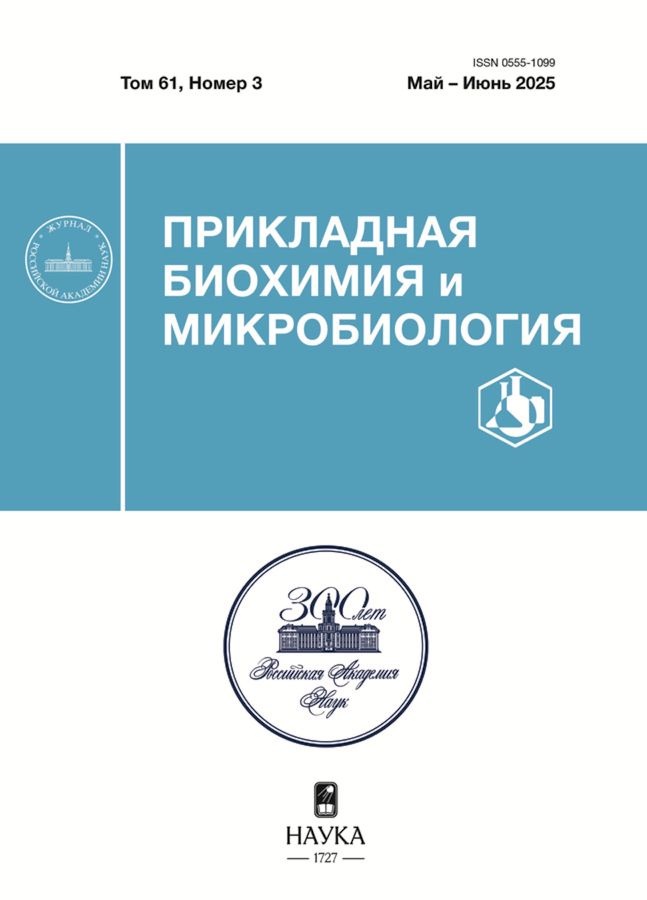Vol 61, No 3 (2025)
Articles
Prospects for application of Bacillus amyloliquefaciens in biocontrol, metabolic engineering and protein expression (review)
Abstract
The article presents the characteristics, composition of metabolites and biotechnological properties of Bacillus amyloliquefaciens including structure, biochemical, ecological, genetic properties, application in plant growing, food industry, medicine, as an alternative to conventional antibiotics. Furthermore, the review addresses environmental applications of B. amyloliquefaciens such as bioprotection in vegetable storage, as plant growth promoters and protectors, and as bioremediation agents. The review aims to understand the characteristics, genetic tools, and metabolic capabilities of B. amyloliquefaciens, highlighting its potential as a base cell for synthetic biology, metabolic engineering, and protein expression. We discuss the role of the bacteria in the production of chemicals, enzymes, and other industrial bioproducts, as well as their applications in medicine, such as combating pathogenic bacteria and promoting gut health. In agriculture, B. amyloliquefaciens has shown potential as a biofertilizer, biocontrol agent with antifungal, antibacterial, insecticidal, antiviral properties, and stress tolerance enhancer for various crops. Despite its many potential applications, B. amyloliquefaciens remains underexplored. The review highlights the need for further research and development of advanced engineering methods and gene editing technologies designed specifically for B. amyloliquefaciens, which will ultimately allow its full potential to be realized in scientific and industrial contexts.
 221-235
221-235


The effect of S-Nitrosoglutathione on the amount and activity of erythroid nuclear factor Nrf2 in human hepatocellular carcinoma cells
Abstract
S-nitrosoglutathione (GSNO) is an endogenous donor of nitric oxide (NO), which, at the same time, can act both as a signaling molecule and a toxic agent, forming active forms of nitrogen. The purpose of this work was to study the mechanism of NO participation in the regulation of erythroid nuclear factor 2 (Nrf2) functioning, which is a redox-sensitive transcription factor. It was shown that when GSNO was exposed to human hepatocellular carcinoma cells (HepG2), the level of intracellular NO increased dose-dependently during incubation for 24 and 72 hours. The maximum increase of NO level at 100 mM concentration led to decrease of the amount of non-protein SH groups, to maximum increase of 3-nitrothyrosine and bityrosine levels, which contributed to the decline of cell viability. The NO donor — S-nitrosoglutation activated Nrf2 during exposure for 24 hours, most likely due to nitrosylation of Keap1 protein, and at 72 hours not only activated Nrf2, but also led to an increase in its amount. This process was carried out through NO-cGMP signaling pathway. Activation of Nrf2 is a key factor in protecting cells from the toxic effects of nitrosative stress products.
 236-248
236-248


Physicochemical and catalytic properties of homogeneous isoforms of γ-hydroxybutyrate dehydrogenase from maize (Zea mays L.)
Abstract
γ-Hydroxybutyrate dehydrogenase (GBDH) is an enzyme belonging to the oxidoreductase class, catalyzing the reversible conversion of succinic semialdehyde (SSA) to γ-hydroxybutyric acid (GHB). It has been established that in maize seedlings, GBDH has mitochondrial (73.7%) and cytoplasmic localization (26.3%). Two homogeneous preparations of GBDH isoforms were obtained from 7-day-old maize seedlings. The purified GBDH1 preparation had a native molecular mass of 60.3 kDa (Mr of individual subunits ~15 kDa). GBDH2, a heteromer with a molecular mass of ~286 kDa, consisted of subunits with Mr ranging from 52 to 66 kDa. The optimal pH values for the obtained enzymes differed: for GBDH1, the optimum pH for the oxidation reaction of γ-hydroxybutyrate was 9.0, while for GBDH2, the optimum pH was 7.0. The kinetics of the enzymatic reaction of GHB conversion to succinic semialdehyde follows the Michaelis-Menten equation. The Km value for GBDH1 with γ-hydroxybutyric acid was 0.31 ± 0.01 mM, and for NAD+ it was 0.47 mM ±0.02. For GBDH2, the Km value with the substrate GHB was 0.7 ± 0.03 mM, and the Km for NAD+ was 0.19 ± 0.01 mM. It was shown that CaCl2 and KCl increased the activity of GBDH1, while MgCl2 had a minor inhibitory effect. The catalytic activity of GBDH2 increased in the presence of CaCl2, KCl, and MgCl2. The study has both fundamental significance, expanding knowledge about the properties of GBDH and its role in plant cell metabolism, and applied significance — data on the mechanisms of regulation of GBDH work can be used to develop methods for increasing the productivity and resistance of plants to unfavorable environmental factors.
 249-259
249-259


Optimization of 1,3-butanediol biosynthesis from glucose through the inverted fatty acid β-oxidation pathway by recombinant Escherichia coli strains
Abstract
In derivatives of Escherichia coli strain MG1655 ∆ackA-pta, ∆poxB, ∆ldhA, ∆adhE, devoid of mixed-acid fermentation pathways, the expression of native L-1, 2-propanediol oxidoreductase and NADPH-dependent aldehyde reductase genes, fucO and yqhD, was enhanced, and Clostridium saccharoperbutylacetonicum butyraldehyde dehydrogenase gene, bld, was expressed. The ability to biosynthesize 1,3-butanediol from glucose resulting from functional reversal of fatty acid β-oxidation was ensured in the recombinants due to the increased expression of the atoB and fadB genes encoding acetyl-CoA C-acetyltransferase and bifunctional (S)-3-hydroxyacyl-CoA dehydrogenase/enoyl-CoA hydratase. Anaerobic substrate to target product conversion of 0.2 mol/mol was achieved with ~4 mM 1,3-butanediol accumulation. When the intracellular availability of NADH equivalents was increased due to constitutive expression of genes of pyruvate dehydrogenase complex, aceEF-lpdA, the conversion of glucose to 1,3-butanediol increased up to ~0.3 mol/mol with accumulation of the target product at the level of ~7 mM. Enhanced expression of the membrane-bound transhydrogenase genes, pntAB, led to the synthesis of 9.5 mM 1,3-butanediol by the yqhD-overexpressing strain with a yield of 0.4 mol/mol.
 260-268
260-268


Synthesis and antibacterial activity of silver nanoparticles stabilized by lipopeptides and glycolipids produced by Bacillus amyloliquefaciens and Pseudomonas fluorescens
Abstract
The colloidal chemical and antibacterial properties of aqueous dispersions of silver nanoparticles stabilized by surfactin and rhamnolipids isolated from B. amyloliquefaciens and P. fluorescens were studied. The isolated biosurfactants were identified by thin layer chromatography and Fourier transform infrared spectrometry. Using the methods of UV-visible spectrophotometry, transmission electron microscopy and dynamic light scattering, the colloidal chemical characteristics of the resulting dispersions were studied. Optimal ratios of the precursor substances were found in which the used biosurfactants perform as effective stabilizers of dispersions of silver nanoparticles and ensure their aggregative stability for at least two months. It was shown that the studied dispersions have antibacterial activity against gram-positive B. subtilis and gram-negative P. aeruginosa and E. coli. A comparative assessment of the antibacterial activity of silver nanoparticles stabilized by biosurfactants and traditional silver-containing preparations, such as a silver nitrate solution and a dispersion of silver nanoparticles stabilized by citrate, was carried out. Furthermore, dispersions stabilized with surfactin showed the highest antibacterial activity, comparable to the effect of a silver nitrate solution, which is associated with their good colloidal stability. In addition, high antibacterial activity of dispersions of silver nanoparticles stabilized with biosurfactants isolated from Bacillus and Pseudomonas bacteria against strains of the other genus was discovered. An explanation of the observed phenomenon is given and the prospects for its application in medicine are proposed.
 269-282
269-282


Degradation of dibutyl phthalate by halotolerant strain Pseudarthrobacter sp. NKDBFgelt
Abstract
Dibutyl phthalate (DBP) is the di-n-butyl ester of ortho-phthalic acid, widely used in the chemical industry as a plasticizer and is a common environmental pollutant. The ability of the halotolerant strain Pseudarthrobacter sp. NKDBFgelt (VKM Ac-3035) isolated from the rhizosphere soil of a salt mining area (Perm Krai, Russia) to use DBP as the sole source of carbon and energy was studied. The strain NKDBFgelt was capable of growth on DBP and ortho-phthalic acid (PA) at high salinity (up to 30 g/L and 50 g/L NaCl, respectively), as well as growth on DBP at a high concentration — up to 9 g/L. The strain degraded 75.2% DBP (initial concentration 200 mg/L DBP) by 72 h of cultivation in the absence of salt. With increased salinity of the medium (30–70 g/l NaCl), DBP degradation was recorded at a level of 66.95–27.8%. Analysis of the genome of the strain NKDBFgelt revealed clusters of genes involved in the degradation of DBP, PA, benzoic acid, as well as genes encoding enzymes of the main degradation pathways of aromatic compounds. The halotolerant strain Pseudarthrobacter sp. NKDBFgelt has a high degradative potential and is promising in the development of new biotechnologies for the restoration of soils contaminated with phthalic acid esters.
 283-293
283-293


Indication of heat shock proteins in conducting suspensions using phage antibodies and an acoustic analyzer
Abstract
There are numerous publications indicating an increase in the expression level of heat shock proteins (HSP) in oncological diseases. Therefore, the development of methods for indicating HSP as a marker of oncological diseases is promising. In this work, phage antibodies specific to HSP of a mouse myeloma cell line were obtained. For the first time, using a compact acoustic sensor, the effect of the conductivity of the measurement medium on the registration of an analytical signal during the interaction of phage antibodies with HSP was studied. The possibility of registering a specific interaction “HSP-phage antibodies” in suspensions with a conductivity of 50-1180 μS/cm was experimentally established. Control experiments were conducted to assess of mass load on the sensor. The results obtained are promising for the development of acoustic sensor systems in the HSP indication.
 294-302
294-302


Effect of brucellin conjugated with gold nanoparticles on the immune response and phagocytosis of brucella
Abstract
A conjugate of 15-nm gold nanoparticles with brucellin, a polysaccharide-protein complex isolated from the Brucella vaccine strain, was obtained. The obtained conjugate was used to vaccinate white mice. The drug was administered intraperitoneally three times with an interval of 7 days. After that, all animals were injected with a suspension of cells of the Brucella abortus 82 vaccine strain. Using a cell proliferative test, it was shown that in the group of animals immunized with a brucellin conjugate with gold nanoparticles, phagocytic cells and splenocytes had higher metabolic activity compared to the group immunized with the native antigen. Moreover, this trend was enhanced after the introduction of the vaccine strain. The highest antibody titer was observed in animals immunized with a brucellin conjugate with gold nanoparticles (1 : 2560 initially and 1 : 10240 after stimulation with the vaccine strain). It is important that during the opsonophagocytic reaction, the level of opsonizing antibodies was very high, which helped neutralize bacteria persisting in the animals.
 303-311
303-311


Effect of fermentation by lactobacilli on the functional — technological properties of pea protein isolates
Abstract
The effect of fermentation with three bacterial preparations: BK-Uglich-K, BK-Uglich-AB and BK-Uglich-P (Russia) on solubility, emulsifying activity, emulsion stability, foaming and foam stability of isolates preparated from two varieties of peas was studied. It has been shown that fermentation with bacterial cultures can increase the solubility of isolates at pH 3 by 4 to 17.5 times, at pH 4 — more than 3 times, at pH 5 — by 23% to 80%, at pH 6 — by 27% to 43%, at pH 7 — by 18% to 27%. Fermentation increased the index of emulsifying activity of isolates at pH 5 by 37% (in one of the varieties), the stability index of the emulsion at pH 3 by 19% to 28%, at pH 4 — by 17%, at pH 5 — by 18% (in one of the varieties), at pH 6 — by 16% to 35%. Fermentation increased the foaming of isolates at pH 3 by 2.2 times, at pH 4 by 1.4 to 2.4 times, at pH 5 and 6 by 1.8 to 4 times, at pH 7 by 2.1 to 2.4 times; at the same time, the stability of the foam of isolates at pH 4 increased by 11% to 22%, at pH 5 — by 11% to 13%, at pH 6 — by 15% (in one of the varieties), at pH 7 — 28% (in one of the varieties). The results obtained made it possible to select bacterial preparations to improve the parameters of pea protein isolates intended for the manufacture of various food products: pea cola (BK-Uglich-P), analogues of fermented milk products and analogues of milk (BK-Uglich-AB).
 312-322
312-322










